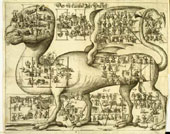- Exhibition program
- Preventive Archaeology
- Artist
- Antonio Gagliano
- Dates
- —
- Curated by
- Oriol Fontdevila
Myths of origins have a function, that of explaining the world. Historical facts, on the other hand, can virtually disappear from our consciousness if we do not insert them into narratives that imbue them with meaning. At the end of the Seventeenth Century, Johannes Buno became one of the last instigators of the Ars Memoriae with the invention of a true method to remember things easily. This method was based on the construction of mnemotechnical images, diagrams that displayed historical events distributed strategically and resulting, at the end, in allegorical figures. Buno, for instance, pictured the Fifth Century as a winged dragon on which a number of events were placed in order on different parts of its body, or drew the Sixth Century in the shape of a strange bear.
Buno assumes that Montjuïc can be also one of these monstrous animals. During the Twentieth Century, the mountain became not only a historical arrangement, but also historiographical, finding its point of departure in the infrastructures that were built for the 1929 International Exposition. In the underground part of the exhibition that took place at the Palau Nacional, a diorama of the Altamira Cave provided Spain with a mythical past. Interestingly enough, this element has also become the cornerstone of the “intelligence accumulation center”, the result, in the words of Antonio Gagliano, of the transformations the entire mountain has accrued over the years.
Buno is a trip through the nets of History, a trip where facts recover the possibility to flow against well-established narratives. It also allows facts to turn around, and become, now, the elements that illuminate the circumstances that produce all those myths that sustain the understanding of History


